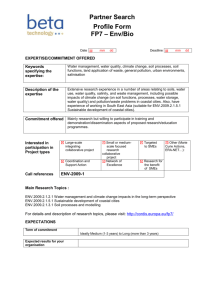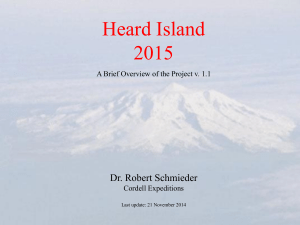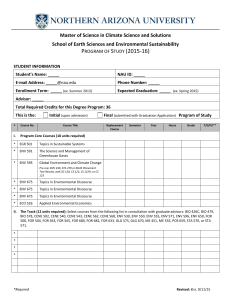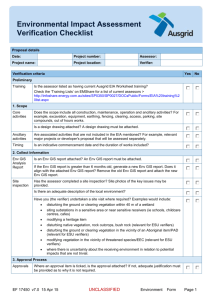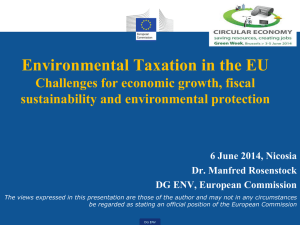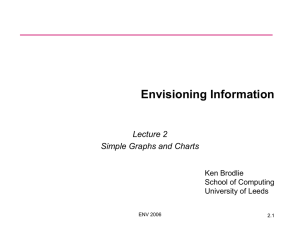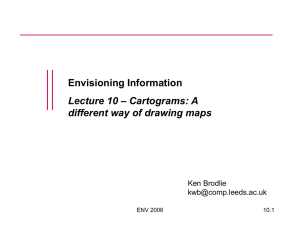Environmental Science Report - Metropolitan State University of
advertisement
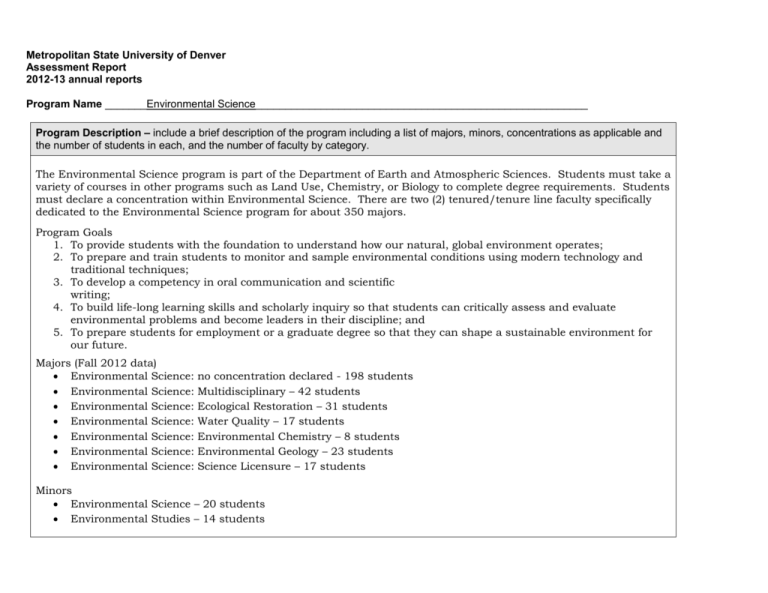
Metropolitan State University of Denver Assessment Report 2012-13 annual reports Program Name _______Environmental Science________________________________________________________ Program Description – include a brief description of the program including a list of majors, minors, concentrations as applicable and the number of students in each, and the number of faculty by category. The Environmental Science program is part of the Department of Earth and Atmospheric Sciences. Students must take a variety of courses in other programs such as Land Use, Chemistry, or Biology to complete degree requirements. Students must declare a concentration within Environmental Science. There are two (2) tenured/tenure line faculty specifically dedicated to the Environmental Science program for about 350 majors. Program Goals 1. To provide students with the foundation to understand how our natural, global environment operates; 2. To prepare and train students to monitor and sample environmental conditions using modern technology and traditional techniques; 3. To develop a competency in oral communication and scientific writing; 4. To build life-long learning skills and scholarly inquiry so that students can critically assess and evaluate environmental problems and become leaders in their discipline; and 5. To prepare students for employment or a graduate degree so that they can shape a sustainable environment for our future. Majors (Fall 2012 data) Environmental Science: Environmental Science: Environmental Science: Environmental Science: Environmental Science: Environmental Science: Environmental Science: no concentration declared - 198 students Multidisciplinary – 42 students Ecological Restoration – 31 students Water Quality – 17 students Environmental Chemistry – 8 students Environmental Geology – 23 students Science Licensure – 17 students Minors Environmental Science – 20 students Environmental Studies – 14 students Student Learning Outcomes (SLOs) These are measurable statements of students’ learning and development reflecting what the program would like students to know, be able to do and/or value. Please insert the appropriate number of rows in the table and letter or number the SLOs for easier reference to data collection and findings. Environmental Science Program Outcomes 1 Students will be able to identify and explain environmental processes and human - environment interactions. 2 Students will be able to apply interdisciplinary perspectives and approaches to environmental problems. 3 Students will be able to critically assess and evaluate environmental problems at a local and global scale. 4 Students will be able to acquire the ability to monitor and sample environmental conditions. 5 Students will be able to design effective oral presentations and scientific papers. Type of Assessment Applicable to Activity SLO(s): Continue to improve content delivery to address a variety of learning styles. Standardized Test data were collected for only Freshman (ENV 1200) and Senior Experience (ENV 4960 & ENV 4970) courses. Communicate more effectively with affiliate 68% 72% 78% 83% 80% faculty about curriculum content. Use additional technology, such as publisher provided software or WebCT software, especially in introductory level courses. 1&3 Possibly introduce another 2000 level class. 4 Point scale Grading Presentation Skills Action and Rationale 2012-2013 2011-2012 1200, ENV 3740, ENV 4010, ENV 4960, and ENV 4970. Data are collected by Dr. Janke and Dr. Ahsan and are administered during both the Fall and Spring semesters. 2010-2011 Data were collected for the following courses: ENV Content Knowledge Target/ Expectation Findings 2009-2010 Data collection Rubric: Oral Presentations on Scientific Papers or Individual Research Projects in which students collect, analyze, and interpret their own data. Continue to use presentations as an assessment method. Students are consistently strong presenters of 1, 2, 3, & 5 3.2 3.4 3.0 3.6 3.0 Continue to encourage students to make use of technology in presentations. Writing Skills Field and Laboratory Skills 4 Point scale Grading Rubric: Scientific Research Papers in which students collect, analyze and interpret their own data or Literature Reviews. 4 Point scale Grading Rubric: Scientific Research Papers or Laboratory/Field Exercises via written reports or field journals material. Continue to use papers as an assessment tool. Students are gradually becoming better writers. 1, 2, 3, & 5 2.8 3.4 3.5 3.4 3.0 Continue 1:1 editing and feedback sessions with students. This is our weakest area, needs additional attention in courses. 4 2.5 2.8 2.9 2.6 3.0 Continue to offer new laboratory courses, including those that focus on water quality. Utilize newly acquired field equipment to enhance student skills. Based on the data listed in the above table, the following conclusions can be made about meeting the expectations for SLOs. This is the first year in which SLO #1 has met our expectations. SLO #4 is below our goal of 3.0. Student Learning Outcome 1 2 3 4 5 Conclusions Met Met Met Not Met Met Process for interpretation of findings – Describe the structure of responsibilities for program assessment. Specify processes undertaken for faculty review of findings prior to submission of this report. How did the program come to the decisions it made? Environmental Science faculty (Dr. Ahsan and Dr. Janke (chair)) have all reviewed and discussed this report. A consensus was made that additional field equipment supplies will potentially enhance student learning though exposure to applied research. We have restructured our courses to focus on small, applied research projects. We hope that this will help us meet our expectations for SLO #4. This committee also feels that a mentoring system for affiliate faculty is necessary to encourage a greater number of participants in the assessment process. Response to prior peer review report(s) - Describe the ways in which the program has responded to any prior year’s peer review report. What kind of continuous improvement cycle are you using? As recommended, analysis was restructured to compare and contrast data from different assessment activities as independent entities. The report now reflects 4 areas (content knowledge, presentations skills, writing skills, and field/laboratory skills) which directly link into the 5 SLOs for the program (see previous table). Additional details about the process of interpreting the findings and decision making with other Environmental Science faculty was added to the report. Faculty plan to make minor modifications yearly, whereas larger changes will coincide with program review schedules. Plans for the program assessment process – To what extent does the program assessment process need modifications? Describe any plans for modifying the program assessment process. Is it the program’s intent to gather data about every outcome every year? If not, what is the proposed data collection cycle? The program assessment plan will be reassessed in year 5. Additional assessment information may be obtained through faculty member’s personal assessment of graduates, a technique used by other programs such as Meteorology. Data will continue to be collected every year until “established” rating is granted through the peer-review process. Implementation plan for applicable program changes - Summarize the changes described in the Action and Rationale columns above and specify the implementation plan including a timeline. Possibly assess additional sophomore level classes in the future. Utilize newly acquired equipment in courses to improve scores for SLO #4 (next 3 years). Course structure has been reformatted with more feedback at specific points for scientific papers (currently implemented). Appendix V V V V V V V V/P V/P V/P V D D V P V V V V/P D D D D V/P V/P P P V P/D P/D P/D P D D P P P P D D D D D V V V V V V V V/P V/P V/P P D D P D P P P P/D P/D P/D D V/P P V P V/D D D D P D D D P D T iers V = Discover (gain knowledge, comprehend information) P = Practice (apply knowledge gained to real situations, issues, and questions) D = Demonstrate (prepare a product that represents knowledge gained, application of knowledge, or evaluation of knowledge) A curriculum map for ENV courses. #5 #4 #3 Name Introduction to Environmental Science World Resources Geol. and Env. Hazards - Denver Water Resources Adv. Geol. and Env. Hazards - Denver Population, Resources, and Land Use Mountain Environments Environmental Remediation Waste Management Environmental Risk Assessment Environmental Health Environmental Geology Environmental Hazards and GIS Environmental Policy and Planning Landscape Ecology Water Law Wetlands Habitat Planning Environmental Biogeochemistry Global Environmental Field Problems: VT T opics in Environmental Science: VT Global Environmental Challenges Environmental Field Studies #2 Course ENV 1200-3 ENV 1400-3 ENV 1540-2 ENV 3400-3 ENV 3540-2 ENV 3620-3 ENV 3700-3 ENV 3710-3 ENV 3720-3 ENV 3730-3 ENV 3740-3 ENV 4000-3 ENV 4010-3 ENV 4200-3 ENV 4400-3 ENV 4410-3 ENV 4420-3 ENV 4430-3 ENV 4500-3 ENV 4910-3 ENV 4920-3 ENV 4960-3 ENV 4970-3 #1 Learning O utcomes P D D Group Members_____________________________________ Class __________________ Learning Outcome Indicators A. Outline and interpret 1. Students will be scientific literature. able to identify and explain environmental processes and human B. Identify human environment impacts (hazards) on interactions. natural systems. 2. Students will be able to apply interdisciplinary perspectives and approaches to environmental problems. 3. Students will be able to critically assess and evaluate environmental problems at a local and global scale. A. Knowledge from other coursework is drawn upon. 4 Exemplary 3 Proficient 2 Apprentice 5 or more credible sources 3 or more credible sources 7 or more credible sources are identified; interpretation are identified; interpretation are identified; interpretation is sufficient, but contains is sufficient, but contains is correct. some minor flaws. some minor flaws. An understandable linkage between human and environmental systems is established; an important problem is identified. Information from courses not offered in the Environmental Science program is abundant; knowledge is successfully integrated with broader environmental themes. An concrete linkage between A linkage of minor human and environmental importance between human systems is established; an and environmental systems essential problem is is established; a problem is identified. identified. Information from courses not offered in the Environmental Science program is adequate; knowledge is indistinctly integrated with broader environmental themes. B. Organize a thorough, systematic approach to the problem that utilizes GIS. Environmental systems are Environmental systems are creatively evaluated from a adequately evaluated, but multidisciplinary perspective minor points are missing. that utilizes GIS. Differentiate between local and global hazards. T opic is clearly defined and well supported by scientific literature; an organized discussion of appropriate project scope is provided. Date _________________ 1 Novice Internet sources are abundant; interpretation contains major scientific errors. An insufficient linkage human and environmental systems is established; a problem is identified. Information from courses not offered in the Environmental Science program is lacking; ambiguous connections with broader environmental themes exist. Information from courses not offered in the Environmental Science program is absent; connections with broader environmental themes do not exist. T he paper is narrowly defined; major points are missing. T he paper is narrowly defined; environmental systems are ignored. T opic is clearly defined and Many topics are identified; supported by scientific T opic is vague and support project does not focus on a literature; project scope is from the scientific literature main issue; support from the loosely tied to local/global is limited. scientific literature is nonissues. existent. 4. Students will be A good GIS approach is able to acquire the A strong GIS approach is Assemble a GIS approach A good GIS approach is developed but is missing ability to monitor and developed; new techniques to investigate the developed; traditional GIS some key elements; sample are implemented to examine environmental problem methods are improved upon. traditional GIS methods are environmental the problem. utilized. conditions. An example of a grading rubric. A poor GIS approach that is missing major elements is developed. Score A. Demonstrate solid writing skills Paper is virtually error-free, is well organized and easy to read, and contains high quality graphics. Paper is well organized and easy to read, contains high quality graphics, and contains few minor grammatical errors. Paper is generally well written but contains some grammatical and/or organizational errors. Paper is poorly organized, contains major grammatical and/organizational errors. Paper contains an B1. Paper contains an Paper contains an Introduction; the problem is Paper does not contain an Introduction; the problem is Introduction; the problem is identified, but could be set up Introduction; the problem is set up clearly; thorough identified, but is not set up more effectively; imprecise; some background background information is well; background background information is information is provided. provided. information is provided. provided. Paper contains Objectives; a main objective and a secondary objective are provided, but other significant objectives are missing. Overall/main objective is incomplete/missing. B3. Paper contains a Study Area description; Paper contains a Study Area Paper contains a Study Area information about size, description; some site description; but does not vegetation type, climate, conditions are addressed but contain specific site soils, elevation, or anything more detail could be conditions. pertinent to paper are provided. provided. Study area description is incomplete/missing. Paper contains Methods; Paper contains a description B4. Paper contains Methods; data acquired and GIS of the Methods; data data acquired and GIS methods are semi-complete acquired and GIS methods are methods are described in but are missing some incomplete and miss major detail. important details. details. Methods are incomplete/missing. B2. Paper contains Paper contains Objectives; a Objectives; a well-defined main objective and a few main objective and multiple secondary objectives are secondary objectives are provided, but others need to provided. be considered. 5. Students will be able to design effective oral presentations and scientific papers. B. Organize a scientific paper Paper contains Results; Paper contains Results; results are reasonable and results are reasonable but Results are show an above average miss some important incomplete/missing. scientific understanding of potential findings. materials. Paper contains Conclusions; B6. Paper contains Paper contains Conclusions; some important conclusions Conclusions; important few important conclusions Conclusions are are drawn from the results; a conclusions are drawn from are drawn from the results; a incomplete/missing. discussion of ways to the results; a discussion of insufficient discussion of Suggested improvements are improve the project is ways to improve the project ways to improve the project not offered. addressed but could contain is offered. is offered. more detail. Student is extremely active, Student is semi active, lets helps solve GIS problems, Student is active, helps solve Student is not active, lets others do most of the work, organizes and edits the some GIS problems, and others do the majority of and writes a section of the paper, and assumes a writes a section of the paper. the work. paper. leadership role. B5. Paper contains Results; results are logical and show a solid scientific understanding of materials. C. Participation in the project An example of a grading rubric. An example of a section from a standardized test. An example of a section from a standardized test.
